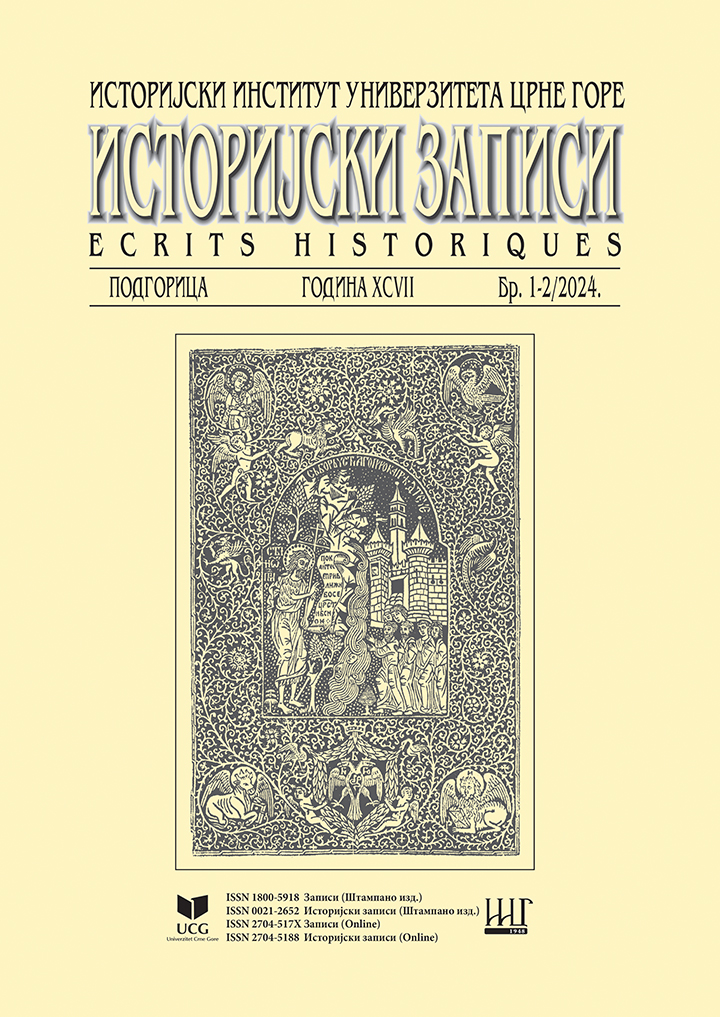Olga Pelcer Vujačić, TRAGOM JEDNOG IZGUBLJENOG NATPISA IZ OKOLINE VUKSANLEKIĆA, (7-12) Download
ABSTRACT: The paper presents the now-lost, fragmentary funerary inscription from the area of Vuksanlekići. Partially reconstructed text of the right part of the inscription indicates it is an epitaph for a child or children erected by their parents. The area of Vuksanlekići has already yielded several funerary inscriptions and milestones and is usually identified as a Roman road station of Cinna.
Wawrzyniec Kowalski, THE CHRONICLE OF THE PRIEST OF DUKLJA IN THE CONTEXT OF EUROPEAN HISTORIOGRAPHY OF THE HIGH MIDDLE AGES, (13-25) Download
ABSTRACT: In this article I try to show the multidivisional structure of the work known as The Chronicle of the Priest of Duklja (Ljetopis Popa Dukljanina) by looking at the model rulers depicted in the text. Each of these figures came from a different European tradition and connects the chronicle to the historiography of different regions of Central and Southeastern Europe. Motifs of Moravian, Czech and ungarian origin, stories known from the northern parts of Dalmatia and local tales from the Dubrovnik area provided a foreground to Duklja-dedicated section of the story, introduced by the figure of St. Vladimir. In this article, I mainly try to appreciate the elements of fiction in the medieval text and by referring to the various traditions of Central European historiography to show its intertextual environment
Matevž Remškar, IVAN UGRINOVIĆ AND HIS WORKSHOP: SOME NEW REFLECTIONS AND PERSPECTIVES, (27-44) Download
ABSTRACT: Ivan Ugrinović emerged as a central figure in Ragusan quattrocento artistic community. Despite the lack of surviving works, extensive archival records in Dubrovnik provide valuable insights into his painting production. Previous writings have often attributed the Koločep polyptych to grinović, but recent restoration and analyses have confirmed that this work dates to the late trecento. grinović is first mentioned in Dubrovnik records in 1420, with his known commissions spanning from 1427 to 1460, documenting at least 33 years of active career. is early contracts with the Ragusan elite suggest he was trained in a prominent painting center before establishing his workshop in Dubrovnik. The peak periods of his commissions were from about 1438 to 1442 and again from 1447 to 1450. Ivan Ugrinović was one of the most productive painters in fifteenth century in Dubrovnik, with an extensive social network and collaborations with masters of related crafts. We hypothetically include in Ivan‘s oeuvre a fragment of a polyptych from the Dubrovnik Franciscan collection depicting St. Blasisu.
Prilozi
Stanko Jovanović, Srećko Živanović, BIJELI PAVLE: U POČETKU…, (45-64) Download
ABSTRACT: Bjelopavlići tribe represents one of the seven hill tribes that inhabit today’s territory of Montenegro. Together with the other tribes (Vasojevići, Kuči, Bratonožići, Piperi, Moračani and Rovci), they form historical and ethnogeographical region known as the Hills. Bjelopavlići tribe is situated in the valley of river Zeta (today’s Danilovgrad municipality). Progenitor of this tribe is believed to be Paul The White (Bijeli Pavle). Who was Paul The White, why did he come and for what reasons, as well as his heritage, are questions which were always quite interesting for members of this tribe. Even though many authors tried to answer these questions through tradition analysis, we are offering a little different aproach in this paper.
Ilija Bajović, BOJ NA CAREVOM LAZU IZMEĐU LEGENDE I ISTINE, (65-78) Download
ABSTRACT: Thesis on the topic Battle of Carev Laz – between legend and truth is written with a goal to introduce readers with opinions of authors that are diametrically opposite but they refer to one occasion which is characterized by many things. The thesis about a great victory of Serbs from Montenegro at the place called Carev Laz is advocated by a group of authors mostly lead by stories from folk tradition. On the other hand, readers are also introduced with a group of authors that explicitly reject every possibility in which Carev Laz represents a place of a great Montenegrin victory.
Mira Šorović, „RASPLETANJE JUGOSLOVENSKIH ČVOROVA” I POLITIČKE INICIJATIVE ZA PREUREĐENJE SFRJ (1989-1991), (79-100) Download
ABSTRACT: The dissolution of the Socialist Federal Republic of Yugoslavia (SFRY) was not an overnight process. This massive federation gradually disintegrated. In an attempt to prevent war and ethnic conflicts, several initiatives aimed to salvage Yugoslavia, although genuine intentions were lacking. Nonetheless, three non-complementary political approaches emerged for reorganizing the SFRY: Slovenia and Croatia advocated for a confederal model, Montenegro and Serbia favored a federal concept with centralist elements, while Bosnia and erzegovina and Macedonia proposed a confederal-federal hybrid model for Yugoslavia’s state organization. Despite these efforts, the entire political endeavor proved unsuccessful-a “traveling circus”. The presidents of the Yugoslav republics, despite projecting their own importance, were ultimately pawns in a larger (geo)strategic game.
Izvori
Božena Miljić, Mateusz Sokulski, IZ ARHIVA HENRIKA BATOVSKOG, (101-111) Download
ABSTRACT: The paper focuses on the content of the personal archive of Henryk Batowski, a Polish Slavist, historian and university professor. The archive is preserved at the Polish Academy of Arts in Krakow. It contains personal documents of Batowski, historical, and literary studies and papers, as well as his correspondence with colleagues from Slavic countries. In this paper, we focus on the correspondence between Batowski and Montenegrin historian Risto Dragićević, regarding the journal „Istorijski zapisi”. Furthermore, we bring two reports written by Henryk Batowski, on the situation in the Kingdom of Yugoslavia between the two World Wars.
Prikazi
Prof.dr Marijan Premović: Mersiha Imamović, SJEVEROISTIČNA BOSNA U ANIČKO DOBA, Univerzitet u Tuzli, Tuzla, 2023, str. 293. (113-116) Download
Dr Budimir Aleksić: Dalibor Elezović, RUSKO-AUSTRIJSKO-TURSKI RAT (1735-1739): IZVEŠTAJI PUKOVNIKA ŽAN ŽAKA BOSOBRA, Istorijski arhiv Kraljevo, Kraljevo, 2023. (117-119) Download

